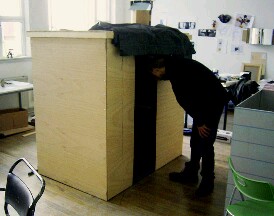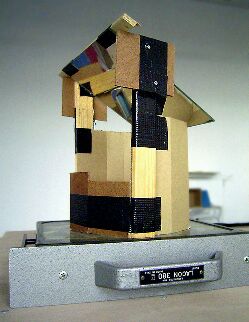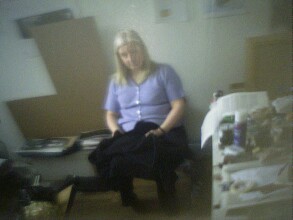



click to enlarge
photography, writing, fine art... stuff ... other stuff ...
The camera obscura has been around for several hundred years, although it doesn't actually seem to have been much used for photography. My interest in it came from trying to open up the camera as an interesting space to be in ... in the sense of going into that space in your head ... and it just seemed the obvious thing to build a camera which you could actually go inside while making the images.
This in itself isn't a new thing ... there is a large Polaroid camera, for instance, where the operator remains inside while the exposure is made ... but this and other instances I am aware of are simply the result of finding the most practical way to deal with very large images ... or, in fact, to deal with the large expanses of film or paper needed to record the images. Nobody seems to have thought of it as a means of taking the viewer inside the camera, and thus putting them inside of the process of image making. It is the experience of being inside the camera that interests me.
However, the idea of using a camera obscura to make photographic images seemed to connect naturally with work I did last year when I drew with a light brush in the darkroom, working directly from the model to make life drawings ... fast gestural drawings which were only revealed when the photographic paper was developed. I enjoyed the quality of line which this gave me, and also found the process of working with a model in the redlit darkroom fascinating. Life drawing introduces movement into the 'still' image, in a way similar to long exposures in traditional photography. It seemed obvious to try and combine the two.
So I intend to use the camera obscura both to make simple photographic images, capturing its characteristic rather soft image quality, but also to draw into these images as they form, and to play with the juxtaposition of a 'photographic' and a 'light drawn' image in the one image space.
Technically, the camera is 1.5m high, 1.5m long, and 1m wide. The lens has a focal length of about 660mm, and is actually one of a pair of condenser lenses from an old large-format enlarger. It is therefore a simple plano-convex lens, uncoated, and of course completely uncorrected. There is tons of both spherical and chromatic abberation. The lens sits on top of the roof or lid of the camera, with a mirror above it angled to direct the scene down into the camera. The focal length is chosen to allow objects roughly 2 to 3 metres away from the camera to be brought into focus at a convenient height for someone sitting on a chair inside the camera. Focus is adjusted by raising or lowering the image plane ... I just use a piece of white foamboard for this. The equations for establishing appropriate focal lengths and the conjugate distances are actually the normal equations that would apply in any large format camera work. The distance was chosen simply because it is a convenient distance from which to work with a model, and the image size was chosen to fit onto standard photographic paper sizes in the range 12x16 to 16x20 inches. A simple pair of rails fixed beneath the lens allow 'Waterhouse stops' to be slid into place to stop the lens down.